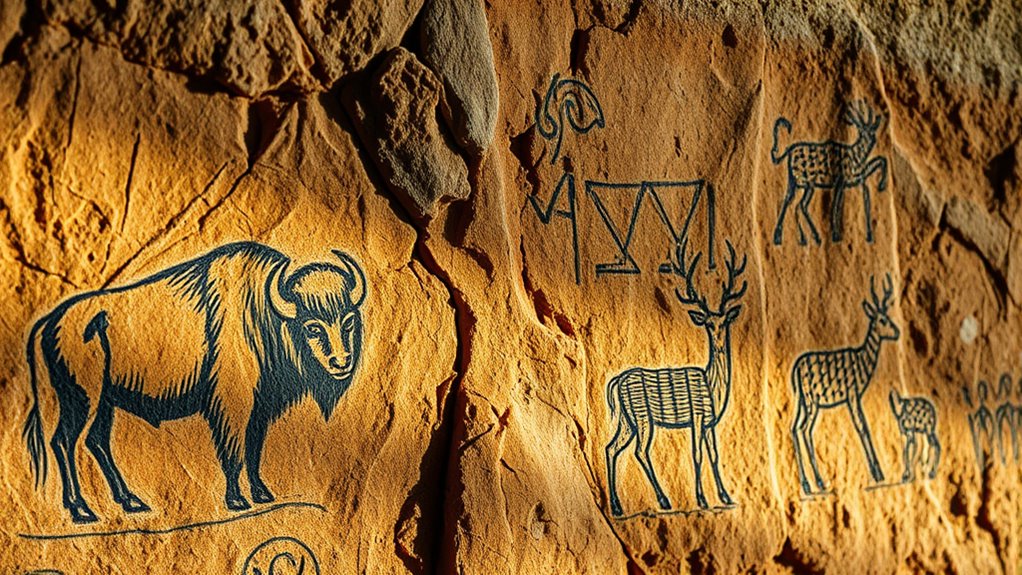Ancient cave paintings still hold secrets because scientists are just beginning to understand their symbolic meanings, techniques, and cultural significance. These artworks reveal early human beliefs, communication methods, and spiritual ideas hidden beneath layers of pigment and time. Advances in modern technology, like chemical analysis and imaging, uncover details that were once invisible. If you’re curious, you’ll discover how ongoing discoveries continue to reshape our understanding of early human creativity and communication.
Key Takeaways
- Advanced analytical techniques reveal hidden layers and faded pigments, uncovering details previously undetectable.
- Scientific methods like spectroscopy identify materials, linking artworks to specific cultural and symbolic contexts.
- Preservation challenges and natural deterioration conceal original features, requiring innovative technologies to explore deeper.
- Many symbols and techniques are complex and layered, necessitating ongoing research to fully interpret their meanings.
- New discoveries continually reshape understanding of early human creativity, showing cave paintings as dynamic repositories of cultural knowledge.

Ancient cave paintings offer a fascinating glimpse into early human life and their way of expressing themselves. As you study these images, you realize they aren’t just random scribbles; they hold symbolic meanings that reveal how our ancestors viewed their world. These symbols may have been used to convey messages across generations, emphasizing their importance in early communication. These symbolic meanings help you understand the mindset of early humans, showing that their art was more than decoration—it was a form of communication. Deciphering these symbols is a complex task, but it provides invaluable insights into their lives and beliefs. You also notice the artistic techniques used in these paintings, which tell you a lot about their skills and intentions. Early artists employed various techniques, from simple outlines to detailed shading, to bring their images to life. They used natural pigments derived from minerals, plants, and charcoal, demonstrating an understanding of their environment and resourcefulness. The way they applied these pigments—whether with fingers, brushes, or blowing pigment through hollow bones—shows their ingenuity. These artistic techniques weren’t just about creating a realistic depiction; they often served symbolic purposes, emphasizing specific features or themes. For example, some paintings highlight the musculature of animals, perhaps to emphasize strength or importance in hunting rituals. You realize that these techniques were carefully chosen to convey specific messages, blending art with storytelling and ritual. As you explore more deeply, you find that the creative methods and symbolic meanings are intertwined. The use of certain colors or shapes might signify particular ideas or spiritual concepts, revealing a rich symbolic language. You see that the paintings were crafted with intentionality, not just as spontaneous expression but as deliberate communication. This understanding makes you appreciate the complexity and depth of early human culture. Additionally, modern scientific tools, such as chemical analysis, are helping researchers uncover even more details about the materials and processes used by ancient artists. These technological advances reveal the complexity of materials and techniques employed, further enriching our understanding of early artistic practices. Moreover, recent discoveries of hidden pigments and layered compositions demonstrate the innovative techniques employed by ancient creators, showing their mastery and depth of knowledge. Scientific methods like spectroscopy are increasingly used to analyze pigment composition without damaging these priceless artworks. Scientists are still uncovering the secrets behind these ancient artworks. Advances in technology, like 3D imaging and chemical analysis, allow you to explore hidden layers or original pigments that have faded over time. Every new discovery helps decode the symbolic meanings embedded within the art and uncovers new artistic techniques. This ongoing research continues to challenge assumptions, revealing that these paintings are more than just primitive sketches—they’re sophisticated records of early human thought, spirituality, and social organization. As you learn more, you realize that ancient cave paintings are not just artifacts; they’re essential keys to understanding the origins of human creativity and expression, still speaking to us across thousands of years.
Frequently Asked Questions
How Old Are the Oldest Known Cave Paintings?
You might find it fascinating that the oldest known cave paintings are around 40,000 years old, showcasing prehistoric symbolism. These ancient artworks reveal early humans’ artistic techniques, using natural pigments and simple tools to create images of animals and abstract designs. Studying these paintings helps you understand how early humans expressed their beliefs and environment, offering a glimpse into their complex culture and the evolution of artistic skills over millennia.
What Materials Did Ancient Artists Use for Their Paintings?
You might think ancient artists only used simple materials, but they employed diverse pigment sources like charcoal, ochre, and minerals. These pigments were carefully prepared and applied with artistic techniques such as blowpipes or brushes made from animal hair. Their resourcefulness allowed them to create vivid images that have endured thousands of years. So, the materials and techniques reveal much about their ingenuity and the cultural importance of their art.
Do Cave Paintings Indicate Early Human Beliefs or Spirituality?
You might wonder if cave paintings reflect early human beliefs or spirituality. They likely do, as many depict animals and symbols linked to symbolic rituals and spiritual symbolism. These images could represent sacred stories, hunting magic, or spiritual connections with nature. By studying these paintings, you can see how ancient humans expressed their beliefs, seeking to understand or influence the world around them through visual storytelling and ritualistic symbols.
How Do Scientists Date and Authenticate Ancient Cave Art?
You can learn how scientists date and authenticate ancient cave art through artifact analysis and stylistic comparison. They analyze pigments, mineral deposits, and tool marks to determine age, often using radiocarbon dating on organic materials. Stylistic comparison helps identify cultural patterns and authenticity by comparing artwork styles to other known artifacts. These methods combined give you a clearer picture of when and how the cave paintings were created.
What Modern Technologies Are Helping Uncover Cave Painting Secrets?
Digital devices deliver dazzling discoveries, as digital imaging and 3D reconstruction uncover hidden details in cave paintings. You can explore intricate images with high-resolution scans, revealing secrets long concealed. These modern marvels make it possible to analyze artwork accurately, allowing scientists to study surfaces and pigments without damage. By harnessing cutting-edge technology, you help unlock ancient artistry, ensuring these prehistoric paintings are preserved and understood for generations to come.
Conclusion
As you explore these ancient cave paintings, remember that scientists have uncovered over 300,000-year-old drawings, revealing humanity’s earliest stories. These images offer a window into our ancestors’ lives, beliefs, and environments. Despite centuries of study, many secrets still remain hidden beneath the rock surfaces. As new discoveries emerge, you’ll see how each painting helps piece together our shared history, reminding us that these ancient artworks continue to inspire and inform us today.









